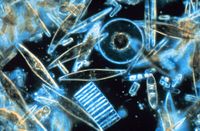
Photo from wikipedia
The toxic diatom genus Pseudo-nitzschia is distributed from equatorial to polar regions and is comprised of >57 species, some capable of producing the neurotoxin domoic acid (DA). In the Pacific… Click to show full abstract
The toxic diatom genus Pseudo-nitzschia is distributed from equatorial to polar regions and is comprised of >57 species, some capable of producing the neurotoxin domoic acid (DA). In the Pacific Arctic Region spanning the Bering, Chukchi, and Beaufort seas, DA is recognized as an emerging human and ecosystem health threat, yet little is known about the composition and distribution of Pseudo-nitzschia species in these waters. This investigation characterized Pseudo-nitzschia assemblages in samples collected in 2018 during summer (August) and fall (October-November) surveys as part of the Distributed Biological Observatory and Arctic Observing Network, encompassing a broad geographic range (57.8° to 73.0°N, -138.9° to -169.9°W) and spanning temperature (-1.79 to 11.7°C) and salinity (22.9 to 32.9) gradients associated with distinct water masses. Species were identified using a genus-specific Automated Ribosomal Intergenic Spacer Analysis (ARISA). Seventeen amplicons were observed; seven corresponded to temperate, sub-polar, or polar Pseudo-nitzschia species based on parallel sequencing efforts (P. arctica, P. delicatissima, P. granii, P. obtusa, P. pungens, and two genotypes of P. seriata), and one represented Fragilariopsis oceanica. During summer, particulate DA (pDA; 4.0 to 130.0 ng L-1) was observed in the Bering Strait and Chukchi Sea where P. obtusa was prevalent. In fall, pDA (3.3 to 111.8 ng L-1) occurred along the Beaufort Sea shelf coincident with one P. seriata genotype, and south of the Bering Strait in association with the other P. seriata genotype. Taxa were correlated with latitude, longitude, temperature, salinity, pDA, and/or chlorophyll a, and each had a distinct distribution pattern. The observation of DA in association with different species, seasons, geographic regions, and water masses underscores the significant risk of Amnesic Shellfish Poisoning (ASP) and DA-poisoning in Alaska waters.
Journal Title: PLOS ONE
Year Published: 2023
Link to full text (if available)
Share on Social Media: Sign Up to like & get
recommendations!